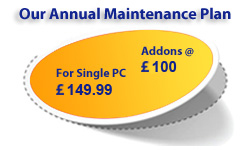Call 0800 031 4181
Windows 8 Computer Slow
- Malicious Browser add-ons and plug-ins.
- Out of date network device drivers.
- Too many applications launched at startup.
- Possible infection from a virus or other malicious software.
- Hard drive fragmentation.
- Limited hardware resources such as RAM or storage drive.
- Start the browser you use for surfing the net.
- Depending on your browser, do one of the following.
- For Internet Explorer: On the Tools menu, click Manage Add-ons.
- For Mozilla Firefox: On the top-right corner, click the Open menu icon, and click Add-ons. In the Add-ons Manager page, select Extensions.
- For Google Chrome: On the top-right corner, click the Customize and control Google Chrome icon, and click Settings. Under Chrome, click Extensions.
- Select the add-ons one at a time and disable them.
- If the browser is fast, the problem is with one of the toolbars. Enable the browser plug-in one at a time to find the malicious one, and keep it disabled.
- If this does not fix the performance issue go to Step 2.
- Computer performance is critically dependent on the speed at which data is sent and retrieved off the network connection.
- This connection can be wired of wireless. Often the network drivers for these devices (e.g. Ethernet Network Interface Card) need to be updated for optimal performance.
- If you connect to the Network with a dial-up connection, you need to update the Modem software. If you connect to the network using a DSL, Cable, or LAN you need to update the driver for the Network Interface Card.
- Microsoft's Windows Update often will automatically update the device drivers. But this process sometimes does not work. Or will use Generic device drivers. So you are better off going to the website of the Device Hardware manufacturer and checking for the latest driver and downloading and installing it.
- If this does not fix the performance issue go to Step 3.
- Fragmentation makes your hard disk do extra work that can slow down your computer.
- To defragment your hard disk, Open Disk Defragmenter applet in the Control Panel.
- Before you decide to defragment the disk, determine if the disk needs to be defragmented or not. Click Analyze disk.
- Once Windows is finished analyzing the disk, you can check the percentage of fragmentation on the disk in the Last Run column. If the number is above 10%, you should defragment the disk.
- Click Defragment disk. Disk Defragmenter might take from several minutes to a few hours to finish, depending on the size and degree of fragmentation.




 I was working with computer technician Atish Patil, the overall experience was good and informative...
I was working with computer technician Atish Patil, the overall experience was good and informative... 

















